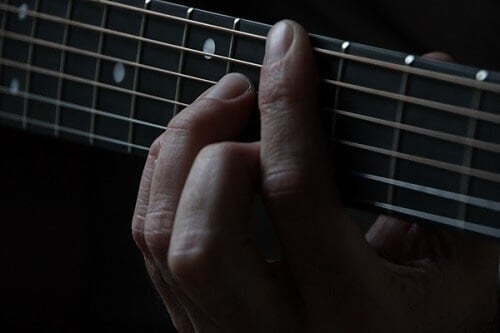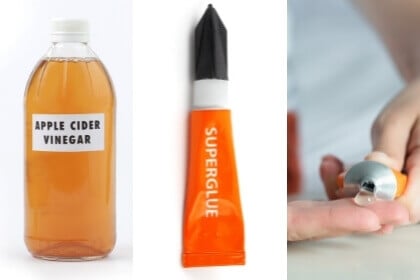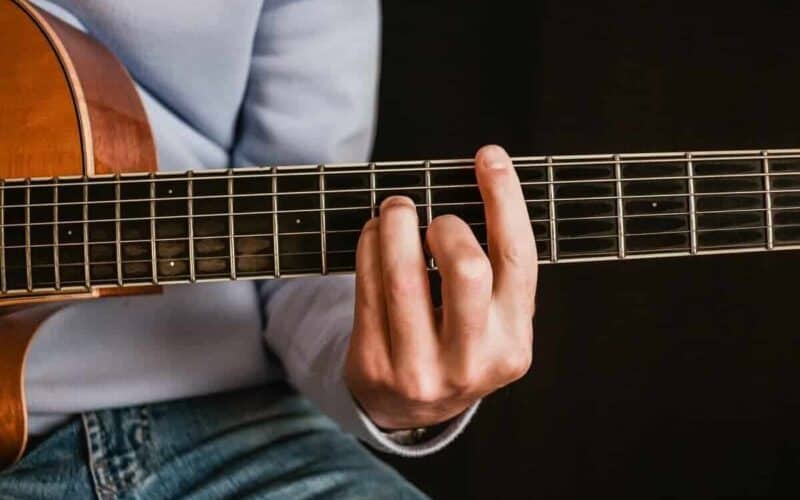The initial weeks of learning the guitar bring a unique challenge. Your guitar fingers are still soft and you find it really hard to press down on the strings. Sore fingers from guitar playing are a common occurrence that can hurt your fingers and make it difficult to practice and improve on the guitar.
As you practice more you will eventually develop finger calluses on your fingertips that will eliminate this problem. But you want to harden fingers for guitar as early as possible.
In this article, I will provide you with several tips on how to toughen up your fingertips for guitar playing as early as possible.
How To Toughen Fingers For Guitar Playing?
So, if you are a beginner guitar player or haven’t been playing the guitar for a while this article will help you get your fingers into shape. Without further ado, let’s get started!
1. Start With An Acoustic Guitar
If you want to develop finger calluses as fast as possible, start with a steel-string acoustic guitar. Acoustic guitars have higher action and thicker strings compared to electric guitars, requiring more pressure on the frets to play. This extra strain helps build calluses.
Making them a bit more strenuous on your fingertips to play. And more strain equals more callus development.
Electric guitars are much easier to play and learn due to thinner strings and lower action. When I’m talking about toughening up your fingertips then any bass guitar with standard strings will do the job also.
2. Use Heavy Gauge Strings
The thicker the strings, the more strenuous they are on the fingers, allowing for greater development by accelerating callus building. Practicing with heavy gauge instead of lighter gauge strings will allow your fingertips to toughen up faster.
3. Take Breaks

When it comes to toughening up your fingers it doesn’t matter how long you practice. What matters is the frequency. Instead of practicing for a long time try practicing in small sessions.
Practicing for too long at a stretch will wear out your fingers and make them sore. It can also cause bruising and tendinitis.
As a result, you won’t be able to touch the guitar for a while. This will cause your newly formed callus to slowly fade away. On the other hand, practicing in small sessions will help you avoid injuries. Allowing you to practice more frequently. This will help you to toughen up your fingertips much faster.
4. Modify Guitar Action (If Needed)
Normally an acoustic guitar with steel strings has higher action and needs more pressure on the strings which will hasten the rate of developing calluses. But if you are playing the guitar with lower action then pressing down on the strings is much easier.
So, if you are serious about toughening up your fingertips then increase the guitar action. You can take your guitar to your local music shop and have the guitar action raised.
5. Don’t Press Too Hard

Beginner guitar players tend to press their guitar strings too hard against the fret. This is because they still haven’t learned the proper techniques. So, they have trouble pressing the strings as close as possible to the fret.
To compensate for their lack of technique they tend to press as hard as possible. This sometimes works and sometimes doesn’t. But still, this is one of the most common bad habits beginner guitarists pick up.
Pressing too hard will increase the chances of you developing soreness, tendinitis, and bruises. As a result, you will refrain from practicing for a long period. This will cause your newly formed callus to slowly diminish.
Try to press on the strings as close to the fret as possible (But not on the fret). This will ensure that you play by applying as little pressure as needed without causing any buzzing sound. Doing this will allow you to practice more which will promote faster callus development.
6. Have Dry Fingers

Don’t play the guitar while your fingers are wet. Wet fingers will sore up and cut more easily. This rule goes even if you have some amount of callus on your fingertips. Calluses will soften up after being immersed in water while doing things like washing dishes, swimming, and bathing, or right after you have applied hand lotion.
If your hands feel wrinkled and your fingertips are still soft after being in the water, wait till your hands are dry and your calluses feel hard again before playing.
Many cleaning products e.g., soaps, shampoo, and even lotions contain conditioners and skin softeners that would not harden your fingers but soften them. Try to avoid those products or use less quantity. You can also wash your hands with alcohol-based waterless sanitizers as a substitute for soap and water.
7. Use Rubbing Alcohol
Famous guitarist Eric Clapton shared his technique of using rubbing alcohol (isopropyl) for toughening up fingertips. To toughen your fingers, just dip a cotton ball or bud into the rubbing alcohol or use alcohol wipes and polish a small amount over your fingertips 3-4 times a day for one or two weeks.
Rubbing alcohol is responsible for drying the skin and hardening the skin. Using this method will toughen up your fingertips. And the best thing is it’s completely painless.
Be cautious to frequently use a large amount of isopropyl alcohol on the skin, it can damage your skin.
8. Practice Every Day

Like I said before, it’s not about the amount of time but the frequency. Sometimes taking breaks is necessary but taking long periods of breaks in between practice sessions will make it hard for your fingers to develop calluses.
As you can’t develop calluses overnight, you have to keep playing and stay with the process. It is important to pass through the callus-building procedure no matter how much your fingers hurt.
If you want your fingers to toughen up as fast as possible then practice every day. Even if it’s just for 15 minutes. Ultimately your fingers will build calluses and that will reduce the pain as well. And when you’ll get used to the process, your guitar playing will be more comfortable.
Another thing to remember is that if you practice the same few chords or notes repeatedly, they can cause grooving. So, practicing different chords and notes helps keep the callus grooves evenly.
9. Avoid Shaving Them Off
This might sound a bit silly at first but you’ll be surprised to know that this is very common. Just like nail-biting, many guitarists form the bad habit of biting or shaving off their calluses.
If you do, you’ll be right back where you started and have to begin the process again.
Sounds like common sense, I know, but you’d be surprised how tempting it gets to gnaw those buggers off, most especially when they are wet and soft from having been in water. So, avoid this as much as you can.
10. Trim Your Nails
Oftentimes you’ll see guitarists with short nails on the fretting hand and long nails on their picking hand. For now, just keep your fingernails on the shorter side and you’ll be set.
Having long nails will prevent your fingertips from properly getting in contact with the strings. Slowing down the toughening process. So, trim them frequently.
11. Use Tools Or A Credit Card
You can’t carry the guitar everywhere with you. So, using finger toughening tools or a credit card can be very useful.
Some guitarists like to keep an old credit card in their pocket to help harden and maintain calluses while they pass time waiting in a bank line or riding a bus. Some people simply dig their thumbnail into their fingertips a lot, right where the string hits the tip.
If you are using a credit card, then press against the edge of the card. This will simulate pressing down on the strings. This can help you to work up your fingers much more frequently and speed up callus formation.
12. Leverage Callus-Building Products
It would be an exaggeration to say that pursuing the above tips will result in the same way for everyone. If you ask me what would be the best way to toughen fingertips or how long it takes to get calluses on your fingers from playing guitar? – The answer varies depending on each person and their activity levels.
Though I have already shared all the best tips that many guitarists implement, there are a few more tricks here.

- Use apple cider vinegar to immerse your fingertips for half a minute before and after each session which will lessen soreness and your fingers will not be oversensitive. Some also say that toothache creams can be used before and after practice as a local anesthetic. This is part of the sore fingers’ guitar remedy.
- There are also some other anesthetic creams or ointments available which will help you to numb the finger pain. Before using any of these numbing agents verify that some of these creams can ruin the color of your guitar fingerboard if you apply it repeatedly.
- Some guitarists put one single drop of Super Glue on the fingertips of the fretting hand as a false callus. This is a temporary solution to reduce finger pain and ultimately won’t benefit you. Also, if you continue using superglue to deal with sore fingers, damage can happen. Check Joe Satriani’s Instagram post.
- You can also try a fingertip protector as a remedy to cut off some of the pain or use finger exerciser tools which will help to develop and maintain finger calluses for guitar players.
Final Words
You really don’t need to add up that much callus for playing the guitar. Calluses should develop naturally through practice over time. Learn the proper techniques that allow you to play comfortably and apply as little pressure as possible.
Now you’ve learned all there is to know on how to toughen fingers for guitar playing. Remember what you’ve learned and practice every day. You’ll become a pro in no time.
About the Author
Gustavo is a music teacher and classical guitar player from Brazil, currently residing in Dublin, Ireland. He holds a graduate degree in Classical Guitar Performance from the Federal University of Pelotas. In 2020, Gustavo successfully completed a Master's degree in Sound Engineering from the Academy of Sound in Ireland.


